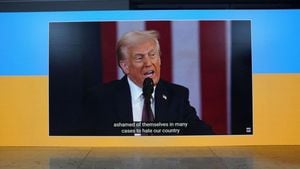For decades, the Monaco Grand Prix has stood as the pinnacle of glamour and prestige on the Formula 1 circuit, drawing fans with its stunning scenery and rich history. Yet, alongside the allure of Monte Carlo, there has been growing criticism about the lack of excitement during the race itself. The narrow, winding streets have often been described as nearly impossible for overtaking, leading to tedious races characterized by predictability. Recognizing these concerns, the FIA and Formula 1 are currently mulling over new regulations to revive this illustrious race by enforcing multiple mandatory pit stops throughout the event.
The initiative was outlined during the recent launch of the 2025 Formula One season at the O2 Arena in London, where officials acknowledged the necessity for change. Last year's race was particularly unexciting— the top ten cars finished exactly as they started, demonstrating how modern F1 cars' size and weight limit opportunities for passing on the challenging 3.4 km track. “With the aim of promoting more competitive racing, the Formula One commission discussed proposals for specific regulations for Monaco,” read the FIA's statement following Tuesday's meeting. The regulation to double the mandatory pit stops aims to increase strategy and unpredictability, turning the Grand Prix from what some have labeled a mere procession back to something thrilling.
Charles Leclerc, currently representing Ferrari, is one of the noteworthy local favorites and has expressed cautious optimism about the proposed changes. With his historic win on home soil last year shattering his Monaco curse, Leclerc is hopeful: “Yeah, because strategy will become a bit more of a thing then, which I think is a good thing.” He suggests multiple pit stops could enrich the racing experience, allowing more strategic elements to come to the forefront of the race day. Yet, he also expresses skepticism about whether these changes can reshape the overall dynamic of the race. “Then, on Sunday, it can get a little bit too... Yeah, there’s not much happening,” Leclerc candidly admitted, indicating the disparity between the excitement of Saturday’s qualifying and Sunday’s race.
This cautious enthusiasm reflects larger sentiments within the racing community. Red Bull Team Principal Christian Horner also provided insight, acknowledging the FIA's struggles with Monaco's unique characteristics: “You can't change the circuit layout.” This indicates the limitations Formula 1 faces, as the existing circuit's design inherently restricts overtaking— raising questions on whether increasing pit stops will effectively generate the excitement sought after by fans.
The new regulations arriving for the 2025 season will not only introduce extra pit stops but also see Monaco shifting its race date to early June starting from 2026, marking the first significant date change since its inaugural event in 1929. This will also be the first occasion Monaco will feature title sponsorship, with luxury watchmaker Tag Heuer stepping up as the title sponsor for the 2025 event. These changes highlight Formula 1's broader strategy to modernize and renew interest not only at Monaco but across the racing calendar.
Still, questions remain. Can mandatorial pit stops alone inject the excitement and unpredictability fans desire, or will the inherent nature of Monaco's track dynamics continue to hamper racing? Historical adjustments aimed at revitalizing interest—like high-degradation tires and DRS—have had mixed results previously. Many are left wondering if simply adding more variables to the equation will yield any significant changes or if the result will still resemble the familiar tune of cars following each other around the circuit.
Interestingly, decision makers aren't the only ones exhibiting caution. Teams across Formula 1 were recently embroiled in the flexi-wing clampdown situation, which saw discussions about postponing regulatory changes between two key races: Imola and Barcelona. The unique profile of the Monaco Grand Prix played heavily on these discussions, with Williams’ principal James Vowles stating, “...it’s really difficult for teams to effectively have the right stock of front wings for Monaco.” This situation indicates the complex interplay of teams’ preparations continually affecting decision-making at the FIA, adding another layer to the Monaco narrative.
Despite the varied responses surrounding potential changes, one overarching truth remains: Monaco is an irreplaceable fixture on the Formula 1 calendar, backed by a contract extending until at least 2031. The race encapsulates more than just speed; it embodies the essence of motorsport heritage. Nevertheless, as Charles Leclerc aptly puts it about the upcoming discussions at the FIA’s F1 Commission, “We’ve got to be open-minded.” The motorsport community is poised at the brink of transition for Monaco—waiting to see if the new regulations will usher the race back to its glory days or if more adjustments will be necessary.
The 2025 Monaco Grand Prix is likely to remain steeped in spectacle, with high hopes riding on the prospect of mandatory pit stops and increased strategy. For fans and teams alike, the excitement is palpable as they gear up for what could be one of the most noteworthy revamps to one of the sport's iconic events. The question now is whether these changes can transform Monaco from simply being the crown jewel to once again living up to its reputation as the pinnacle of Formula 1 racing.



